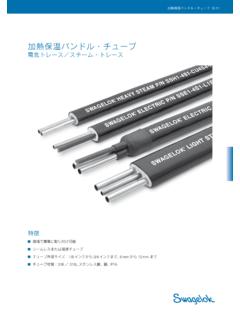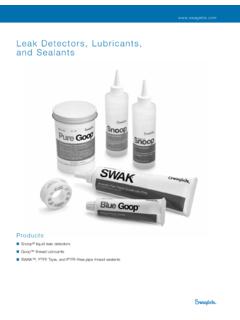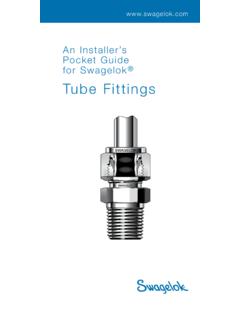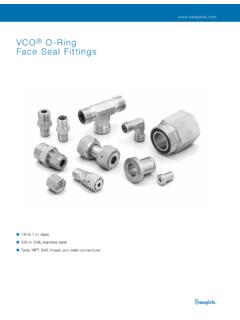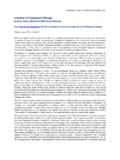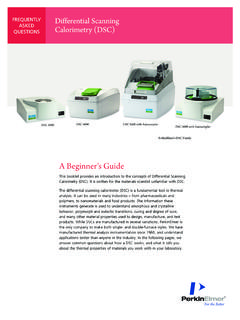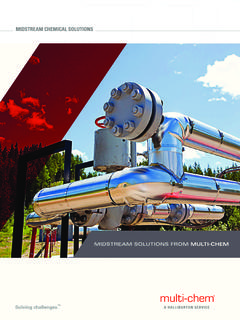Transcription of Grab Sampling Systems - Swagelok
1 Provides a simple, effective way to safely collect samples Keeps samples in their representative state for analysis Can be adapted to meet system requirementsGrab Sampling Systems Application GuideSwagelok Application Solutions Swagelok offers a series of solutions for use in all types of plants and facilities where fluids are being processed. Use Swagelok application solutions to create fully documented fluid Sampling and control Systems and bring consistency to your operations. Easy to install and operate, these solutions offer the high quality and support you expect from Sample Cylinders (GSC) Features .. 22 Outage Tubes ..23 Assembly Descriptions .. 24 Materials of Construction .. 25 Pressure-Temperature Ratings .. 25 Testing .. 25 Cleaning and Packaging .. 25 Dimensions .. 26 Ordering Information .. 27 Liquid-Only Sampling System (GSL) Features .. 28 Configuring a Descriptions .. 29 Materials of Construction .. 36 Pressure-Temperature Ratings.
2 36 Testing .. 37 Cleaning and Packaging .. 37 Flow Data .. 37 Dimensions .. 38 Ordering Information .. 40 Accessories .. 42 Glossary - Schematic Symbol Definitions .. 43 What is grab Sampling ? ..3 Why Use a grab Sampling System? ..3 Sampling Basics .. 3 Specifying a grab Sampling System .. 4 grab Sampling System Installation Tips .. 5 Configurations .. 5 grab Sample Module (GSM) Features .. 7 Configuring a GSM ..8 System Descriptions .. 8 Materials of Construction .. 17 Pressure-Temperature Ratings .. 18 Testing .. 19 Cleaning and Packaging .. 19 Flow Data .. 19 Dimensions .. 20 Ordering Information .. 21 ContentsA Swagelok Application Solution grab Sampling Systems3 What is grab Sampling ? grab Sampling , also known as lab Sampling or spot Sampling , is the collecting of a sample of liquid or gas in a pipeline, tank, or system with the intent of transporting the sample to a laboratory for Use a grab Sampling System? grab Sampling can validate: process conditions end products meet quality specifications online analyzers are fit for use product quality during custody transferIt can also provide verification of environmental emissions.
3 In all of these uses, capturing a representative sample is , placing a captured sample into an open bottle for transport back to the lab may not provide a representative sample. Some chemicals will evaporate or fractionate if not maintained under pressure. As more industries bring additional analytical equipment online, it becomes more imperative to have quality sample Systems that can accurately capture the process for later analysis . Sampling BasicsSampling is the science of safely capturing a sample from a process or a pipeline while maintaining the chemical composition during storage or transport for later analysis . Depending on the process phase, temperature, consistency, chemical makeup and other factors, there are a variety of approaches that can be used to extract a sample. Determining the container type needed is the first decision that must be made in order to select the appropriate PhaseContainer TypePressure-ContainingNon Pressure-ContainingLiquid Cylinder Cylinder Bottle BottleVapor Cylinder Cylinder Bottle Bottle = recommended = not recommended The product selection matrix on page 6 includes additional common system criteria.
4 grab Sampling System with PurgeA Swagelok Application Solution grab Sampling Systems4 Another important aspect is the temperature of the system fluid. Many processes operate at elevated temperatures and can pose a hazard from direct scalding during operator interaction or from the temperature limits of seats and seals being exceeded. Swagelok recommends consideration of a sample cooler when the supply temperature exceeds 140 F (60 C.) Note that thermal stability may affect sample a grab Sampling SystemThe Swagelok grab Sampling Systems provide solutions to satisfy gas and liquid non-slurry Sampling service in a consistent, reliable package. Two system types allow for capture into one of two types of containers pressure-containing metal cylinders as found in the grab Sample Module (GSM) or non pressure-containing glass or polyethylene bottles as found in the Liquid Only Sampling Module (GSL). Given the wide variety of configurations available, there will be several criteria to consider in order to properly specify a grab Sampling system: Pressure: Each GSM and GSL system has a maximum rated pressure, not to be exceeded.
5 Note: The use of a rupture disc or relief valve is recommended with chemicals that may rapidly expand and pressurize due to temperature changes. Temperature: Each GSM and GSL system has a maximum fluid operating temperature. Note: Some models may have reduced pressure ratings at elevated temperatures. Also, some models may have minimum fluid operating temperatures, below which proper function cannot be assured. Phase: A cylinder sampler (GSM) can be suitable for either liquid or vapor Systems . A bottle sampler (GSL) may not prevent the release of vapors and is better suited for most non-volatile liquid Systems . Hazardous/flammable material: The Sampling system must provide sufficient protection for the operator and environment from the system fluid. Certain chemicals such as aqueous chlorine and pyrophoric compounds require more stringent leak or chemical protection than may be provided by a Swagelok GSM or GSL. Materials of Construction (including coatings, etc.)
6 : The materials used in the Sampling system must be compatible with the system fluid. The standard material of construction for Swagelok Sampling Systems is 316 stainless steel. Alternate materials such as brass and alloy 400 are available for some configurations. Surface treatments: Surface treatments can reduce the absorption and adsorption of the sample fluid into metallic surfaces, leading to a more representative sample. Electropolished (EP) tubing is available. In addition to or in place of electropolishing, many coatings can be applied to the wetted components: SilcoNert , Silcolloy , and Dursan are frequently requested coatings. Contact your authorized sales and service center for details. Purge: Some chemicals may leave residue or contaminate the lines if not flushed from the system. Selecting the purge option provides a means to introduce a purge fluid (air, solvent, etc.) to remove residual contamination from the sample Swagelok Application Solution grab Sampling Systems5 grab Sampling System Installation TipsManual sample Systems can be installed to draw from any point along a pressurized line where there is enough process or head pressure to drive the sample fluid through the process tubing.
7 They may be used in an analyzer bypass or return the sample panel requires a return, ensure that the transport line is being returned to a lower pressure location, preferably through a separate tap. If the motive force from a pump is being used, the return sample can be placed upstream of the pump, as the flow through the pump will be sufficient to dilute any sample stream being returned to the should always be installed so that sample vessels (cylinders or bottles) remain oriented vertically. Failure to do so may result in contaminated samples. CAUTION: When installing a Swagelok grab Sampling system, position the vent away from operating personnel. Always open vent/purge valves slowly. Operating personnel must protect themselves from exposure to system offers two categories of grab Sampling Systems to fill a variety of intended grab Sample Module (GSM) is a Sampling panel using cylinders for capturing either liquid or gas into a sealed, pressure-containing vessel.
8 Closed loop Sampling provides a sample that is fresh and extracted and held under the same process conditions that existed at the time of sample, with the exception of temperature. The sample vessel is docked in place and the process fluid is continuously circulated through the sample vessel. This means when the sample vessel is ready to be removed, the flow is isolated and the vessel is immediately ready to be removed no waiting for lines to flush or bottles to fill. A sample receiver is required for the capture of the sample with a GSM the grab Sample Cylinder (GSC). The sample cylinders available are approved for transportation and are available with DOT or TPED approvals. Rupture discs are standard. Relief valves and expansion chambers are offered as Sample Module with PurgeA Swagelok Application Solution grab Sampling Systems6 The grab Sample Liquid (GSL) is a liquid-only Sampling system for drawing fluid into a non-pressure containing bottle which can be drawn and transported without the risk of spillage or evaporation.
9 This can be accomplished by using a bottle with a self-sealing septum cap. Bottles are a lower cost collection option that can be replaced easily if conditions warrant. Fixed volume samplers are an option that can be implemented for improved safety. This option completely separates the process pressure from the sample bottle and the user, preventing over-filling and overpressure conditions. See pages 34 and 35 for additional Selection Matrix This table provides a summary of common system criteria and the grab Sampling system recommended for the listed StorageSample ReceiverSample PhaseContinuous Flow PurgeFixed VolumeBack PurgeOrdering NumberReference Page NumberYe sCylinderLiquidNoNoYe sNoGSM-L-1(-N)9Ye sCylinderLiquidNoYe sYe sNoGSM-L-1(-P)10Ye sCylinderLiquidYe sNoYe sNoGSM-L-2(-N)13Ye sCylinderLiquidYe sYe sYe sNoGSM-L-2(-P)14Ye sCylinderGasNoNoNoNoGSM-G-1(-N)11Ye sCylinderGasNoYe sNoNoGSM-G-1(-P)12Ye sCylinderGasYe sNoNoNoGSM-G-2(-N)15Ye sCylinderGasYe sYe sNoNoGSM-G-2(-P)16 NoBottleLiquidNoNoNoNoGSL129 NoBottleLiquidNoYe sNoNoGSL230 NoBottleLiquidYe sNoNoNoGSL331 NoBottleLiquidYe sYe sNoNoGSL432 NoBottleLiquidNoYe sNoYe sGSL533 NoBottleLiquidNoNoYe sNoGSL634 NoBottleLiquidYe sNoYe sNoGSL735 Fixed Volume Sample SystemA Swagelok Application Solution grab Sampling Systems7 grab Sample Module (GSM)
10 Features The GSM uses pressure-rated sample cylinders which prevent the sample from escaping, even under pressure, and are durable to prevent accidental breakage. The GSM is the most reliable method of capturing a GSM closed-looped Sampling system pulls from a positive-pressure process and returns back to the process at a lower pressure location ( upstream of a pump), using the differential pressure to drive the fluid through the sample system. This circuit draws a flow path that connects to the sampler then returns to the process or to flare. A GSM can be left in the bypass or sample position indefinitely when using this arrangement, keeping the transport lines fresh (with zero flushing time) and ready for sample capture. A rupture disc is an available option for every GSM system. A relief valve can also be added to the Sampling Systems where there is additional concern regarding overpressure of the sample cylinder from temperature changes or overfilling.



